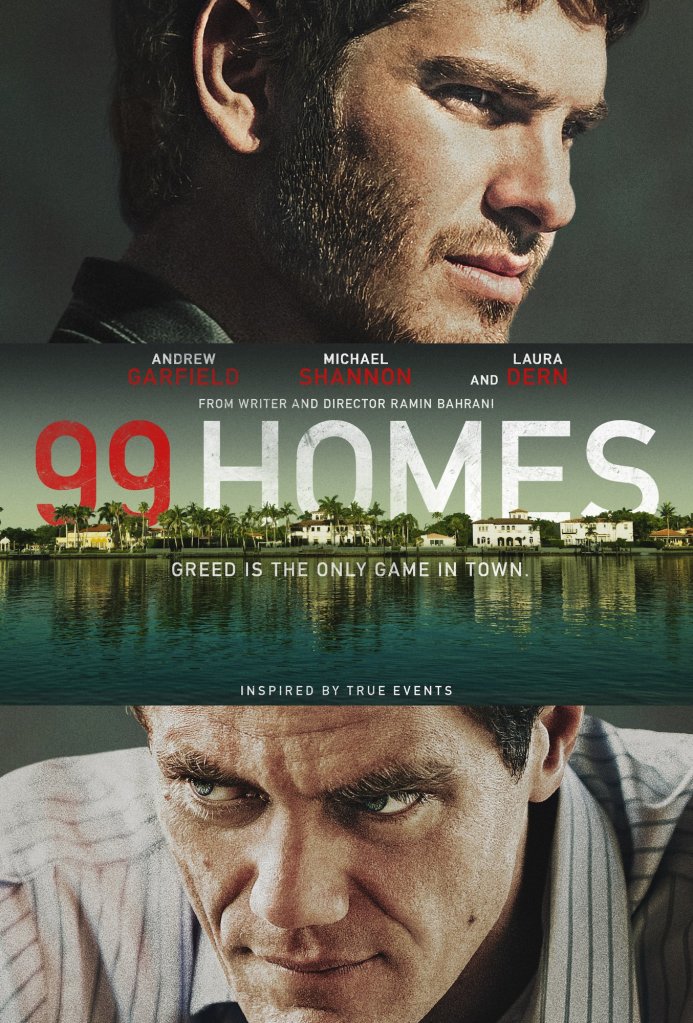“It’s only after we’ve lost everything that we are free to do anything.”
—Tyler Durden, Fight Club
That anything can be devastating. Stripped of social responsibilities and courtesies, even the best will behave like a dog backed into a corner. It’s the stuff of high drama, and it courses through the veins of the writer/director Ramin Bahrani.
For Bahrani, the key is to explore the personal without losing sight of the political, and when it came to America’s housing crisis, the two intersected with a potent poignancy. Set in Orange County, Fla. in 2010, 99 Homes shows both sides of the hotly debated argument over what caused the housing collapse. Were banks giving out unstable loans to clients they knew couldn’t pay them back? Yes. Were homeowners taking out more than they could afford and then blaming their default on a series of external circumstances? Absolutely. Was there an endless line of crooks between the lenders and the lendees taking more than their fair share? You bet. So who is to blame? It was hard to tell then, and it’s harder to tell now. Desperate people in desperate situations need to point the finger at someone or something. The accuracy of that accusation is rarely a concern. All that matters is: it’s theirs, not my fault.
Opening with a bravura single-take shot, 99 Homes drops the audience inside one of the more tragic moments of the movie, a man being evicted has opted to kill himself rather than lose his house. Overlooking this grisly scene is the home’s realtor, Rick Carver (Michael Shannon), the man who came carrying the unfortunate news. How he responds to this tragedy and how he conducts his business shows that this is not his first rodeo, nor does he expect it will be his last.
Bahrani shifts the story to Dennis Nash (Andrew Garfield), a single father taking care of his son, Connor (Noah Lomax), and mother, Lynne (Laura Dern). The three have been living in the house for decades, and a few years ago, Nash borrowed against the house. When work in the construction, electrical, and plumbing business dried up, Nash couldn’t make the payments, and the bank foreclosed on the house, transferring the ownership of the home to Carver Realtors.
In a cruel twist of fate, the only work Nash can find is as Carver’s lapdog. First as a day laborer, then as an accomplice for Carver’s shady deals, and finally as Carver’s business partner. The transformation is complete, and now Nash is the one who has to go out and do the dirty work of evicting people. Carver does what one with money can do, manipulate. And with a snap of Carver’s crooked fingers, Nash watches his conscious circle the drain.
There are contrivances to Bahrani’s plotting, but they all manage to build in a satisfactory manner. The main goal here is to watch a man become what he hates: not out of want, but out of necessity. And it shines brightest during the eviction scenes, where Bahrani and cinematographer Bobby Bukowski capture these painful moments via cinema vérité. Bahrani wants us to witness these moments and these people at their lowest point to remind us that they are not numbers or statistics but human beings. Handheld shots move from face to face while they talk and yell over each other. About the cops, about an appeal process, about a 30-day waiting period, about representation, about anything they can grab on to. They lash out; they cry; they are human. One heart-wrenching scene involves the eviction of a senile man, whose wife engineered a reverse mortgage before she died years earlier. The widower has no friends, and his only family member is a son several states away and they are no longer on speaking terms. He doesn’t even know the name of his neighbors. One officer whispers that he’ll drive him to the Red Cross after they’re done clearing out his home.
What becomes clear is that these homeowners simply don’t know what is going on and that can’t understand how a collection of small decisions led to this momentous occasion. They don’t know who owns their home, who sold it to whom, who Carver is and why they suddenly have to leave. They are utterly hopeless, have no one to turn to, and no idea where to begin.
Carver tells Nash: “Don’t be soft. They all got a sob story.” A cynical echo of Jean Renoir’s sentiments in The Rules of the Game, “The awful thing about life is this: Everybody has their reasons.” Carver is at times monstrous, but he was made, not born that way. The finger he points is at those who bite off more than they can chew. It’s easy to vilify him, and the movie ultimately does, but Carver is just another product of the recession. The only difference is that Carver will stop at nothing to ensure that he never ends up on the curb holding all of his possessions.
But that killer instinct has cost Carver dearly, and he is lost to the world. The hope then lies with Nash. He may be tempted, he may be swayed, but the hope of America’s future lies in the hands of those who refuse to cross a certain line. Bahrani has hope. 99 Homes instills that hope.
Directed by: Ramin Bahrani
Written by: Ramin Bahrani, Amir Naderi
From a story by: Ramin Bahrani, Bahareh Azimi
Produced by: Ashok Amritraj, Ramin Bahrani, Justin Nappi, Kevin Turen
Starring: Andrew Garfield, Michael Shannon, Laura Dern, Noah Lomax
Broad Green Pictures, Rated R, Running time 112 minutes, Opens October 9, 2015



You must be logged in to post a comment.